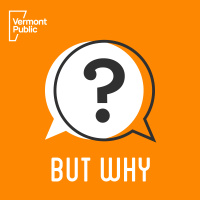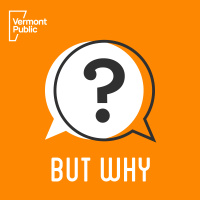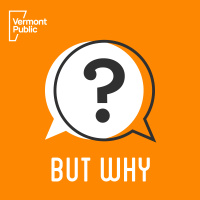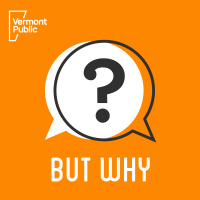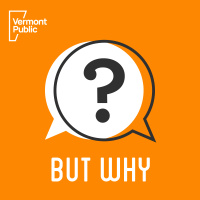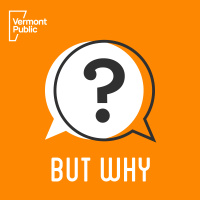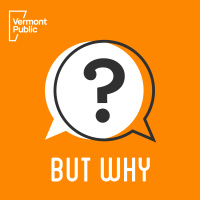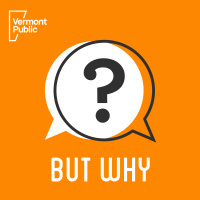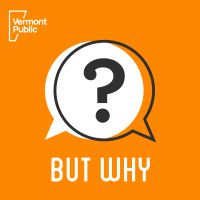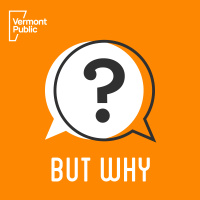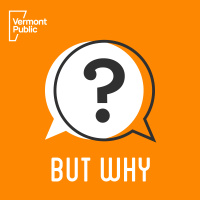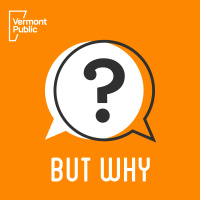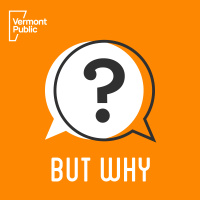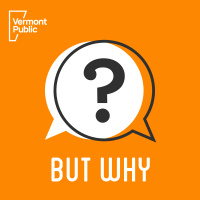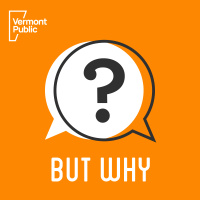Synopsis
But Why is a show led by kids. They ask the questions and we find the answers. Its a big interesting world out there. On But Why, we tackle topics large and small, about nature, words, even the end of the world. Know a kid with a question? Record it with a smartphone. Be sure to include your kid's first name, age, and town and send the recording to questions@butwhykids.org!
Episodes
-
Who invented emoji?
18/11/2022 Duration: 21minEmoji are those little images you can send in text messages to friends and family. Nine-year-old Leila in New Jersey wants to know how they were invented. So in this episode we find out with Jane Solomon, editor at Emojipedia and Paul Galloway of the Museum of Modern Art in New York. We learn what the first emoji looked like, way back in the dark ages of the 1990s and we explore how emoji may be a new trend, but communicating through pictures is a very old tradition. Plus, are emoji…art? Give this episode a
-
How did dinosaurs leave tracks?
04/11/2022 Duration: 30minBut Why has answers to your dinosaur questions! When did the dinosaurs live? How many species of dinosaurs were alive in the Cretaceous period? How do dinosaurs get their names (and why are they hard to say)? Why are dinosaurs extinct? We visit Dinosaur Valley State Park in Texas to see some actual dinosaur evidence: tracks left by two types of dinosaur 113 million years ago. Download our learning guides: PDF | Google Slide | Transcript Dinosaur Valley State Park in Glen Rose, Texas has several sites where dinosaur footprints have been well-preserved. Though some of the tracks were actually chiseled out and sold before the park got state recognition and protection. In the summer of 2022, drought in this part of Texas caused riverbeds to dry out, revealing new tracks that hadn’t been seen before. These discoveries made news around the world! The rock in the area is limestone. And the tracks are largely in what are now riverbeds. But In the time of the dinosaurs, 113 million years ago, the landscape looked v
-
How is cheese made?
21/10/2022 Duration: 22minKids love cheese! (So do adults: Americans consume an average of 40 pounds of cheese per person per year.) In this episode we learn how cheese is made and answer all of your cheesy questions: Why are there different types of cheese? Why do cheeses have different flavors? How do you make Colby Jack cheese? How does cheese get its color? And why do we say cheese when we take a picture? We visit the Cabot Cheese factory and talk with Maegen Olsen and Panos Lekkas. Download our learning guides: PDF | Google Slide | Transcript Cheese starts with milk. Cheese is often made with milk from cows or goats, but it can also be made with milk from sheep, buffalo, camels or other mammals. (There’s even a moose-cheese company in Russia!) If the cheese is made in bulk to sell to lots of people, companies will usually run tests on the milk before they turn it into cheese. They want to make sure it doesn’t have bad bacteria or antibiotics in it. The milk is then pasteurized, which means it’s heated quickly and cooled quickl
-
How do bees make honey and why do they sting?
07/10/2022 Duration: 31minWhy do bees pollinate? How do they make honey? Why do bees have stingers? Why do (some) bees die when they sting you? What's the difference between a bee and a wasp? Does honey have healing properties? Farmer and beekeeper John Hayden answers all of your bee questions! Download our learning guides: PDF | Google Slides | Transcript | Coloring Page Bees collect nectar from flowers. Nectar is the sweet liquid that entices the bees to the flower. The bees climb onto or into the flower and suck up the nectar with their straw-like mouth and collect it in a little sac called a crop. They also collect pollen on their legs. As they move from flower to flower, they leave a little bit of that pollen on each new flower they visit. That's called pollination and it’s how flowers reproduce. Bees take the pollen and nectar back to their hives and put it into the honeycomb (six-sided cells they have built out with wax). Pollen is like protein, one of the building blocks of animal bodies, and bees use that to feed their you
-
Why do sharks have so many teeth?
23/09/2022 Duration: 28minWhy do sharks have multiple sets of teeth? Why do sharks lose so many teeth? Do sharks eat fish? How do sharks breathe underwater? Do sharks sleep? Give a listen to this totally jaw-some conversation about sharks with Dr. Kady Lyons, shark researcher at the Georgia Aquarium! We also tackle: Why are dinosaurs extinct and sharks are not? Were megalodons the biggest sharks in the world? Do sharks have noses? How do sharks communicate? Why do sharks bite? Why are sharks dangerous? Download our learning guides: PDF | Google Slide | Transcript Sharks are a type of fish. They’ve been around for millions of years and their body plan hasn’t changed much in that time! Sharks’ skeletons are made of cartilage. They don’t have any calcified bones - so the only part of a shark that gets left behind in fossil records is their teeth! Megalodons were the biggest shark, but they are extinct (despite sensational TV shows that claim otherwise). The latest research suggests megalodons were bigger than modern day humpback whal
-
How do popcorn kernels pop?
09/09/2022 Duration: 25minHow do popcorn kernels pop? How do salmon know where to return to spawn? How do rabbits change colors? Why does television fry your brain? How do zippers zip stuff? Who was the fastest runner in the world? In this episode, we'll tackle all of these questions! Download our learning guides: PDF | Google Slide | Transcript Inside the husk is a tiny little droplet of water surrounded by something called the endosperm. The endosperm is what you're actually eating when you eat popcorn. When you heat up popcorn, the tiny droplet of water gets hot and turns into steam. That steam pushes through the endosperm and turns it kind of soft and that endosperm builds up pressure and explodes through the husk. When it explodes, that soft gelatinous endosperm hits cooler air and it hardens up in whatever shape it has exploded into. So that's why popcorn has all those funny shapes and feels kind of like foam. Salmon are born in freshwater, but then spend their lives in saltwater. They return to the freshwater to spawn (lay
-
How do snakes slither?
26/08/2022 Duration: 33minField trip time! Today we’re learning all about snakes while out on a search for timber rattlesnakes in New York with state wildlife biologist Lisa Pipino. Some of the questions we tackle: How do some snakes make venom? Why are some snakes venomous and others are not? Why do rattlesnakes have a rattle? How do snakes slither on the ground without legs? Why don’t snakes have legs? Why don’t snakes have ears? How do they smell with their tongues? Why do some snakes use heat vision? Do snakes sleep? Why do snakes stick out their tongues so much? Download our learning guides: PDF | Google Slide | Transcript Snakes are ectothermic - meaning they are cold-blooded and rely on their environment to regulate their body temperature. Snakes like to bask on warm rocks to stay warm. A rattlesnake’s first rattle segment is called a button. They shed their skin once or twice per year and each time they do, they get a new rattle segment. Rattle segments sit on top of each other, and when rattlesnakes shake their tail, the s
-
Why do we feel pain?
12/08/2022 Duration: 22minWhy do we feel pain when we get hurt? What is pain? Why do we cry when we get hurt? Why do we say ow or ouch? We’re learning about how pain works with Joshua Pate. He’s a physical therapist and author of a forthcoming children’s book series about pain. Download our learning guides: PDF | Google Slide | Transcript Pain happens when your body sends signals to your brain that something is wrong. And your brain sends signals to your body to feel pain! Pain is protective–it lets us know to stop doing something that is damaging or might damage our bodies. And it lets us know that something is wrong and we might need to get help from an adult or a medical provider. When you get hurt, like scraping your knee for example, the nerve cells in the knee send a message to the brain. Your eyes might see the scraped knee and send another message to your brain. Then your brain has to decide how much danger your knee is in. Pain is messaging that lets your brain know that something is not well. If you didn’t have that pain,
-
Why do we have friends?
29/07/2022 Duration: 44minWhy do friends care about each other? How do you make friends? Can you have more than one best friend? How do you deal with a bully? We answer questions about friends and bullies with Dr. Friendtastic (also known as Eileen Kennedy-Moore), a psychologist and author of Growing Friendships: A Kids’ Guide to Making and Keeping Friends. And we get lots of advice from kids themselves about how to make friends and deal with bullies. Download our learning guides: PDF | Google Slide | Transcript Friendship is often about action. It's about what we do together, how we treat each other. The key to friendship is kindness. Best friends are nice, but the word “best” can make it feel like a contest. Most people have different friends and for different situations. So it’s okay to have several close friends instead of needing to identify just one best friend. Some people have lots of friends, but other people may just have a few close friends. People with more friends tend to put more effort into having more friends. It’
-
Why do crickets chirp?
15/07/2022 Duration: 26minHow are crickets so loud? Why do they chirp at night? How are they different from grasshoppers? We’re talking crickets today with Karim Vahed, a cricket and katydid expert and entomologist (bug scientist) at the University of Derby in the United Kingdom. Professor Vahed also takes on some of your pressing insect questions: Do insects have bones? What do baby bugs like to do? Do insects drink water? Why are bugs so important? Download our learning guides: PDF | Google Slide | Transcript There are over 9,000 known species of crickets on the planet. These insects are best known for singing and hopping! Insects are divided into different orders depending on what kind they are. Crickets are in the order known as Orthoptera, which contains grasshoppers, locusts, crickets and bush crickets, and katydids. Crickets and grasshoppers are different! For one thing, most grasshoppers make noise by rubbing one of their legs against one of their wings. But most crickets make sound by rubbing their two forewings (their fr
-
Who doesn’t love ice cream?
01/07/2022 Duration: 26minThat’s just one of the questions we answer in this week’s episode, which also includes instructions on how to easily make your own ice cream at home! We’ll also tackle the why and how of melting ice cream and why some flavors tend to melt faster than others! Our expert in this episode is ice cream entrepreneur Rabia Kamara, of Ruby Scoops in Richmond, Virginia. It's going to be sweet! Download our learning guides: PDF | Google Slide | Transcript After listening, if you're ready to try making ice cream at home, here's Rabia's easy recipe. INGREDIENTS: 2 cups of heavy cream 1 14oz can of sweetened condensed milk Optional additional flavorings: a splash of vanilla pinch of salt And whatever else you might want to add! (Chocolate chips, cookie crumbles, etc.) INSTRUCTIONS: Use a hand mixer to beat the heavy cream until it is the consistency of whipped cream, with peaks that hold their shape. Fold any additional ingredients into the sweetened condensed milk and add the mixture to the heavy cream and f
-
Do you have to be tall to play basketball? Questions for the Washington Mystics
17/06/2022 Duration: 27minThe Washington Mystics of the WNBA join us in this episode to answer all of your questions about the sport of basketball and what it’s like to be a professional athlete. How many basketballs does the team have? Why do balls spin when you bounce them? Who invented basketball? Why are basketballs orange with black lines? Why do men and women play on separate teams? How do injuries impact professional careers? And do you have to be tall to play hoops? Download our learning guides: PDF | Google Slide | Transcript Resources Basketball Games for Kids Learn More About the WNBA
-
Why are pandas black and white?
03/06/2022 Duration: 25minFor the past 50 years, visitors to the Smithsonian National Zoo in Washington, D.C. have been able to observe giant pandas. It’s one of the few places in the United States to see these black and white bears. For our latest episode we took a field trip to the zoo to visit the three pandas currently living there and answer panda questions with zookeeper Mariel Lally. We tackle: Why do animals live in the zoo? Why are pandas black and white? Do pandas hibernate? How can we save the pandas? And check out our social media pages for lots of pictures! Download our learning guides: PDF | Google Slide | Transcript Three pandas live at the National Zoo: adults Tian Tian and Mei Xiang and their cub, Xiao Qi Ji. Zookeepers are never in the same space as the pandas. Even though they are herbivores, pandas are still wild animals with sharp claws and big teeth, so it’s important for people to stay safe. Researchers at the National Zoo have worked with colleagues in China on a breeding program for both captive and wild p
-
What is climate change?
20/05/2022 Duration: 26minWhat is climate change? What is causing climate change? How do you cool down the earth? How is climate change affecting the oceans? Kids are hearing about climate change and they have lots of questions. In this episode we explain the science of climate change and look at how humans will adapt to a rapidly warming planet. We speak with Dr. Claudia Benitez-Nelson, oceanographer at the University of South Carolina and Dr. Jola Ajibade, a geographer at Portland State University. This certainly isn’t a comprehensive look at the issue, but it’s a good way to start a conversation about this issue for families and teachers. Download our learning guides: PDF | Google Slide | Transcript Climate is the long-term trend of temperatures and weather. You can think of the difference between climate and weather like a dog walking down a sidewalk: The dog might go from side to side of the sidewalk - that’s kind of like the weather - it varies. But the general direction of the dog is forward - that’s the climate. Since the 1
-
Why do flowers bloom?
06/05/2022 Duration: 21minWhy do flowers bloom? How do flowers grow? Why are flowers different colors? Why do people find flowers beautiful? How are seeds made? Why do plants grow from seeds? Why do we put seeds in the garden? We’re answering your questions about seeds and flowers with garden writer Charlie Nardozzi and Hannes Dempewolf from The Crop Trust. Find more answers to plant questions in two of our older episodes: How Do Big Plants Grow From Such Small Seeds? and Are Seeds Alive? Download our learning guides: PDF | Google Slide | Transcript New seeds are made through pollination, plant reproduction. Pollen makes its way to the ovary of a flower in various ways. Sometimes it is spread from one flower to another by a pollinator, like a bee or hummingbird. Some flowers are called “perfect”, meaning they can reproduce with their own pollen–not the pollen from another plant. But they still need a way for their own pollen to drop onto their egg. A gentle gust of wind, or the jostling of the plant by a gardener's hand can do the
-
Why are some people left-handed?
22/04/2022 Duration: 27minWhy are some people right-handed and some are left-handed? And what’s up with some people being ambidextrous (equally good with both hands)? Why, in the past, did some people try to make left-handed people use their right hands? We talk with Chris McManus, professor and author of the book Right Hand, Left Hand: The Origins of Asymmetry in Brains, Bodies, Atoms, and Cultures. We’ll even find out how common left-handedness (or left-pawedness) is in other animals! Download our learning guides: PDF | Google Slide | Transcript Why do we prefer one hand over the other? McManus says it probably pays to specialize. It’s better to do something with one hand over and over and get really good at it, as opposed to doing it sometimes with one hand and sometimes with the other. For example, it takes years to develop your handwriting, so it would take twice as long to develop good handwriting with both hands! How do we pick which hand? We chose the hand that feels more normal to us, and then we practice with that hand. T
-
Why do pigs oink?
08/04/2022 Duration: 31minWhy do pigs snort? And why do we call their snorts “oink” in English? We’re taking our exploration of animal noises in two directions today. First we’ll learn about why we use different words to describe animal noises, depending on what language we’re speaking. And then we’ll examine what animals are actually saying when they oink or tweet or moo! Our guests are linguist and author Arika Okrent and bioacoustic researcher Elodie Briefer, of the University of Copenhagen. Other questions we tackle in this episode: Do cows make different amounts of “moos” to say different words? Why do ducks make loud noises? Why do roosters cockadoodle-do in the morning? PLUS, so many kids sent us animal noises in different languages and we’ll hear them all! Download our learning guides: PDF | Google Slide | Transcript Bioacoustics is the study of sounds made in nature. Scientists like Elodie Briefer study how animals make sounds and what information we can find in those sounds. Scientists will record sounds and use computers
-
How much does the moon weigh?
25/03/2022 Duration: 20minWe’re bringing back an episode from the archives, all about the moon: Why does the moon change shape? How much does it weigh? What color is it? Why does the Earth only have one moon? Why does it have holes? Where does it go when we can't see it? Why do we sometimes see it in the daytime? And why does the moon look like it's following you when you're in the car? Answers to your moon questions with John O'Meara, chief scientist at the W.M. Keck Observatory. Download our learning guides: PDF | Google Slide | Transcript | Coloring Page We can see the moon during the day for the same reason we see the moon at night. The surface of the moon is reflecting the sun's light into our eyes. But we don't see the moon all the time during the day, and that's because of where the moon might be in the sky. There are times where the moon is on the other side of the earth so we can’t see it. We see the moon in the sky when it’s in the right spot and it’s reflecting enough light to be brighter than the background of the sky.
-
Why is Russia invading Ukraine?
11/03/2022 Duration: 24minThe invasion of Ukraine has been the top story in the news for the last few weeks, and kids around the world are asking questions about what is happening and what it means for them. In this episode we ask Erin Hutchinson, Assistant Professor of Russian History at the University of Colorado Boulder, to help us understand the history behind this conflict. Adults: we don’t go into detail about what war looks like on the ground, but we acknowledge war is a scary topic. You may want to preview this episode ahead of time to make sure it's right for your kids. Download our learning guides: PDF | Google Slide | Transcript We have collected some resources for parents/caregivers about how to talk to kids about war and ways families can help. How to talk to kids about war Meet the Helpers Common Sense Media News Sources for Kids from Common Sense Media NAMLE Parent’s Guide to Media Literacy Ways To Help Save the Children UNICEF Eurasia Foundation Donations for refugees in Moldova
-
How did people keep food cold in olden times?
25/02/2022 Duration: 23minViolet, 5, wants to know: what was life like before refrigerators? And Ellinor, 6, asks: how did they make ice in the old times? In this episode, we learn about the history of ice harvesting and the industry that built up around it, where ice cut from lakes in New England was shipped to as far away as India and the Caribbean. We hear more about this history from Gavin Weightman, author of The Frozen Water Trade. And we visit Rockywold-Deephaven Camps in New Hampshire, where ice is still harvested each winter from Squam Lake and used to keep old fashioned ice boxes at the camp cool all summer long. Download our learning guides: PDF | Google Slide | Transcript Before refrigeration, people stored food in a lot of different ways. Food would be smoked, dried, salted, fermented or pickled. It would also be kept in root cellars or pits underground. Wealthy people who lived in cold climates were more likely to have an ice pit or later an ice house where they would keep ice for use in warm months. In the 1800s, a

